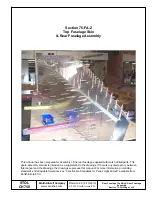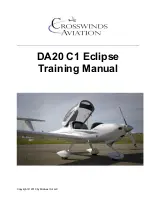
PREPARATION
07
IMPORTANT
Using the accelerator
or the trimmers
decreases the angle
of attack and makes
the wing more prone
to collapse, therefore
using the accelerator
or releasing the
trimmers near to the
ground or in turbulent
conditions should be
avoided.
Never apply the brakes
whilst using the speed
system - it makes the
wing more prone to
collapse.
It is recommended
to pilot the wing with
the rear risers during
accelerated flight.
Accelerator System
To set up the accelerator system, first route the lines supplied with the speed system through the
harness. Make sure this is done correctly and that the lines pass through all of the pulleys (check your
harness manual for instructions). Attach the speed system lines to the accelerator system on the risers
with the Brummel hooks.
A basic set-up can be performed on the ground: ask a friend to pull the risers tight into their in-flight
position whilst you sit in the harness on the ground. Now adjust the lengths of the lines so that the
main bar sits just beneath your seat. You should be able to hook your heel in to the lower loop of the
accelerator.
There must be enough slack in the speed bar to ensure the front risers are not pulled down in normal
trim speed flight, but not so long that it is impossible to use the full speed range of the glider. Fully
extending the lower loop will accelerate the wing to approximately half its accelerated speed range.
For full speed, hook your heels on to the upper bar and smoothly extend your legs, maximum speed
is when the pulleys on the risers touch. Once set up, test the full range of the accelerator in calm flying
conditions and ensure that both risers are pulled evenly during operation. Fine-tuning can be completed
when you are back on the ground.
Harness
It is important to set up your harness correctly before flying the wing. Make sure to spend time adjusting
your harness’s different settings until you are completely comfortable.
Wing
To prepare the wing, lay it out on the top surface and perform a thorough daily check. You should
inspect the top and bottom surfaces for any rips and tears or any other obvious signs of damage. Lay
out the lines one side at a time, hold up the risers and starting with the brake lines, pull all lines clear.
Repeat with the stabilo, D (uppers), C, B and A lines, laying the checked lines on top of the previous set,
and making sure no lines are tangled, knotted or snagged. Mirror the process on the other side and then
inspect the lines for any visual damage. Then inspect the risers for any signs of obvious damage. If you
have any doubts please get advice from experienced pilots or your local dealer or instructor.
Содержание Zero 3
Страница 1: ...EN Pilots Manual...
Страница 30: ......
Страница 31: ...1258 Route de Grasse Le Bar sur Loup 06620 France...






































